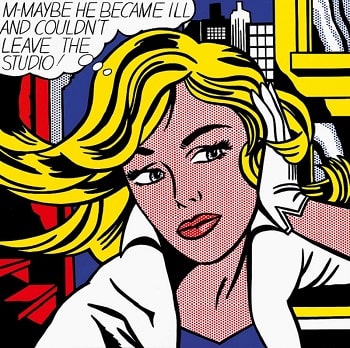M-Maybe, 1965 by Roy Lichtenstein by Roy Lichtenstein

M-Maybe presents us with one of Lichtenstein's standards: an idealized, romance novel-type woman placed within a generic cityscape setting. Characteristically colored in the primary
hues of red, yellow and blue, Benday dots color the woman's skin while adding reflection to the background windows. Comprising nearly the entire surface of the painting, the blonde,
windswept-haired woman holds her gloved hand to her face in worry, while we read her almost hopeful expression that her beau has become ill rather than, the viewer is forced to presume, having
forgotten about her. Through this single comic strip image Lichtenstein creates an amusing tension - the viewer searches for a deeper narrative surrounding the absent companion even while
the concern of the woman - impeccably dressed and hair stylishly coiffed - is overshadowed by her stylish glamour.
In the early 1960s, Roy Lichtenstein developed his signature style so famously associated with the Pop art movement - the reproduction of cartoon and other appropriated imagery on a large
scale, making no (readily apparent) changes to the source material. With a pictorial language consisting of heavy, black outlines and flat colors, Lichtenstein combined the fine art technique
of painting with machine reproduction in a manner that removed the trace of the artist's hand altogether.1 In so doing, Lichtenstein depersonalized the images, making witty observations
and jokey criticisms hidden behind a seemingly anonymous process.
